[English] 日本語
 Yorodumi
Yorodumi- PDB-4z6x: The 1.68-angstrom crystal structure of acitive-site metal-free Pq... -
+ Open data
Open data
- Basic information
Basic information
| Entry | Database: PDB / ID: 4z6x | ||||||
|---|---|---|---|---|---|---|---|
| Title | The 1.68-angstrom crystal structure of acitive-site metal-free PqqB from Pseudomonas putida | ||||||
 Components Components | Coenzyme PQQ synthesis protein B | ||||||
 Keywords Keywords | HYDROLASE / PqqB / PQQ / Pyrroloquinoline quinone / metallo-beta-lactamase / lactamase | ||||||
| Function / homology |  Function and homology information Function and homology information | ||||||
| Biological species |  Pseudomonas putida (bacteria) Pseudomonas putida (bacteria) | ||||||
| Method |  X-RAY DIFFRACTION / X-RAY DIFFRACTION /  SYNCHROTRON / SYNCHROTRON /  MOLECULAR REPLACEMENT / Resolution: 1.68 Å MOLECULAR REPLACEMENT / Resolution: 1.68 Å | ||||||
 Authors Authors | Tu, X. / Wilmot, C.M. | ||||||
 Citation Citation |  Journal: To Be Published Journal: To Be PublishedTitle: Crystal structures of PqqB reveal metal-binding plasticity at the active site of PqqB Authors: Tu, X. / Wilmot, C.M. | ||||||
| History |
|
- Structure visualization
Structure visualization
| Structure viewer | Molecule:  Molmil Molmil Jmol/JSmol Jmol/JSmol |
|---|
- Downloads & links
Downloads & links
- Download
Download
| PDBx/mmCIF format |  4z6x.cif.gz 4z6x.cif.gz | 146.5 KB | Display |  PDBx/mmCIF format PDBx/mmCIF format |
|---|---|---|---|---|
| PDB format |  pdb4z6x.ent.gz pdb4z6x.ent.gz | 113.6 KB | Display |  PDB format PDB format |
| PDBx/mmJSON format |  4z6x.json.gz 4z6x.json.gz | Tree view |  PDBx/mmJSON format PDBx/mmJSON format | |
| Others |  Other downloads Other downloads |
-Validation report
| Summary document |  4z6x_validation.pdf.gz 4z6x_validation.pdf.gz | 429.5 KB | Display |  wwPDB validaton report wwPDB validaton report |
|---|---|---|---|---|
| Full document |  4z6x_full_validation.pdf.gz 4z6x_full_validation.pdf.gz | 431.7 KB | Display | |
| Data in XML |  4z6x_validation.xml.gz 4z6x_validation.xml.gz | 14.9 KB | Display | |
| Data in CIF |  4z6x_validation.cif.gz 4z6x_validation.cif.gz | 21.8 KB | Display | |
| Arichive directory |  https://data.pdbj.org/pub/pdb/validation_reports/z6/4z6x https://data.pdbj.org/pub/pdb/validation_reports/z6/4z6x ftp://data.pdbj.org/pub/pdb/validation_reports/z6/4z6x ftp://data.pdbj.org/pub/pdb/validation_reports/z6/4z6x | HTTPS FTP |
-Related structure data
| Related structure data | 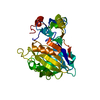 3jxpS S: Starting model for refinement |
|---|---|
| Similar structure data |
- Links
Links
- Assembly
Assembly
| Deposited unit | 
| |||||||||
|---|---|---|---|---|---|---|---|---|---|---|
| 1 | 
| |||||||||
| Unit cell |
| |||||||||
| Components on special symmetry positions |
|
- Components
Components
| #1: Protein | Mass: 34123.656 Da / Num. of mol.: 1 Source method: isolated from a genetically manipulated source Source: (gene. exp.)  Pseudomonas putida (strain KT2440) (bacteria) Pseudomonas putida (strain KT2440) (bacteria)Strain: KT2440 / Gene: pqqB, PP_0379 / Production host:  |
|---|---|
| #2: Chemical | ChemComp-ZN / |
| #3: Water | ChemComp-HOH / |
-Experimental details
-Experiment
| Experiment | Method:  X-RAY DIFFRACTION X-RAY DIFFRACTION |
|---|
- Sample preparation
Sample preparation
| Crystal | Density Matthews: 2.92 Å3/Da / Density % sol: 57.87 % |
|---|---|
| Crystal grow | Temperature: 285 K / Method: vapor diffusion, hanging drop / pH: 6.7 / Details: PEG4000, NaCl, BisTris |
-Data collection
| Diffraction | Mean temperature: 108 K | ||||||||||||||||||||||||
|---|---|---|---|---|---|---|---|---|---|---|---|---|---|---|---|---|---|---|---|---|---|---|---|---|---|
| Diffraction source | Source:  SYNCHROTRON / Site: SYNCHROTRON / Site:  APS APS  / Beamline: 23-ID-D / Wavelength: 1.03 Å / Beamline: 23-ID-D / Wavelength: 1.03 Å | ||||||||||||||||||||||||
| Detector | Type: DECTRIS PILATUS 6M / Detector: PIXEL / Date: Feb 22, 2014 | ||||||||||||||||||||||||
| Radiation | Protocol: SINGLE WAVELENGTH / Monochromatic (M) / Laue (L): M / Scattering type: x-ray | ||||||||||||||||||||||||
| Radiation wavelength | Wavelength: 1.03 Å / Relative weight: 1 | ||||||||||||||||||||||||
| Reflection | Resolution: 1.68→28.9 Å / Num. obs: 46746 / % possible obs: 99.4 % / Redundancy: 4.5 % / Biso Wilson estimate: 30.01 Å2 / CC1/2: 0.998 / Rmerge(I) obs: 0.045 / Rpim(I) all: 0.023 / Net I/σ(I): 18.2 / Num. measured all: 211169 | ||||||||||||||||||||||||
| Reflection shell | Diffraction-ID: 1 / Redundancy: 4 % / Rejects: _
|
- Processing
Processing
| Software |
| ||||||||||||||||||||||||||||||||||||||||||||||||||||||||||||||||||||||||||||||||||||||||||||||||||||||||||||||||||||||||||||||
|---|---|---|---|---|---|---|---|---|---|---|---|---|---|---|---|---|---|---|---|---|---|---|---|---|---|---|---|---|---|---|---|---|---|---|---|---|---|---|---|---|---|---|---|---|---|---|---|---|---|---|---|---|---|---|---|---|---|---|---|---|---|---|---|---|---|---|---|---|---|---|---|---|---|---|---|---|---|---|---|---|---|---|---|---|---|---|---|---|---|---|---|---|---|---|---|---|---|---|---|---|---|---|---|---|---|---|---|---|---|---|---|---|---|---|---|---|---|---|---|---|---|---|---|---|---|---|---|
| Refinement | Method to determine structure:  MOLECULAR REPLACEMENT MOLECULAR REPLACEMENTStarting model: 3JXP Resolution: 1.68→27.896 Å / FOM work R set: 0.9052 / SU ML: 0.15 / Cross valid method: FREE R-VALUE / σ(F): 1.36 / Phase error: 15.77 / Stereochemistry target values: ML
| ||||||||||||||||||||||||||||||||||||||||||||||||||||||||||||||||||||||||||||||||||||||||||||||||||||||||||||||||||||||||||||||
| Solvent computation | Shrinkage radii: 0.9 Å / VDW probe radii: 1.11 Å / Solvent model: FLAT BULK SOLVENT MODEL | ||||||||||||||||||||||||||||||||||||||||||||||||||||||||||||||||||||||||||||||||||||||||||||||||||||||||||||||||||||||||||||||
| Displacement parameters | Biso max: 163.17 Å2 / Biso mean: 43.11 Å2 / Biso min: 17.93 Å2 | ||||||||||||||||||||||||||||||||||||||||||||||||||||||||||||||||||||||||||||||||||||||||||||||||||||||||||||||||||||||||||||||
| Refinement step | Cycle: final / Resolution: 1.68→27.896 Å
| ||||||||||||||||||||||||||||||||||||||||||||||||||||||||||||||||||||||||||||||||||||||||||||||||||||||||||||||||||||||||||||||
| Refine LS restraints |
| ||||||||||||||||||||||||||||||||||||||||||||||||||||||||||||||||||||||||||||||||||||||||||||||||||||||||||||||||||||||||||||||
| LS refinement shell | Refine-ID: X-RAY DIFFRACTION / Total num. of bins used: 17
|
 Movie
Movie Controller
Controller


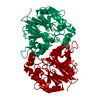
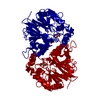
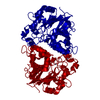
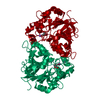



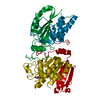

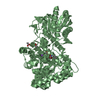

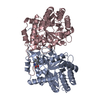
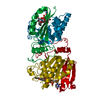
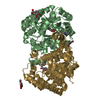
 PDBj
PDBj




